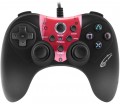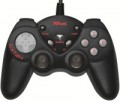Cable length
The length of the cable provided in the design or delivery set of the wired or combined controller (see "Connection").
In general, the meaning of this parameter is obvious: a longer cable gives more freedom of movement, but can create inconvenience at short distances. In fact, the length of the wire is important mainly in cases where a wired connection is used to play on a large screen: for comfortable viewing, it is desirable to be at a fairly large distance from such a screen. However, even in this case, a relatively short cable can be compensated for by the length of the wires going from the console (or other gaming device) to the screen, or even by connecting the set-top box to the screen wirelessly (many modern models have this capability). If the controller is used for a computer, this parameter can be ignored: the system unit or laptop is usually located in close proximity to the user, and even a fairly short wire is enough to connect.
Feedback
The type of feedback provided in the design of the manipulator (if any).
Feedback is the reaction of the manipulator to certain events occurring in the game. This reaction enhances the "immersion effect", giving the player the impression that he is holding on to a real airplane handle, car steering wheel, etc. It can be like this:
—
Vibration. Feedback in the form of vibration allows you to simulate, for example, shaking from off-road driving, aircraft trembling when firing from airborne weapons or entering a turbulence zone, etc.
— Power.
Force feedback controllers are able to create some resistance to the efforts of the player — for example, to simulate the difficulty in turning the steering wheel when the wheels are stuck in the mud.
— Vibration / power. Controllers that support both types of feedback described above. This option is the most advanced and at the same time the most expensive.
D-pad
The presence of the
D-Pad manipulator in the controller design; the type of such a manipulator can also be specified here.
D-Pad is used to move the character, cursor, etc. in strictly defined, standard directions. In some cases, this can be more convenient than using analogue levers that tilt to either side (see below). As for the varieties, nowadays there are such options:
— 4-position. The classic D-Pad, which appeared at the dawn of game consoles and does not lose popularity nowadays. Available as a set of 4 buttons in a distinctive cross-shaped layout, or as a single solid "multi-sided" button. Anyway, such a device provides 4 fixed directions: up, down, right, left. But to move diagonally, you need to select 2 corresponding directions at once; this is not always convenient, so in this regard, 4-way D-Pads are considered somewhat less practical than the 8-way ones described below. On the other hand, they are also quite functional, while being simpler in design, reliable and inexpensive; and strictly diagonal movements are not required as often as horizontal and vertical ones. So this type of D-Pads can be found even in accessories for the latest generations of game consoles.
—
8-position. A variation of the D-Pad, in which 4 standard directions (2 horizontal, 2 vertical) are supplemented by 4 intermediate — diagonal. In this case, we are usually talking about full-fledge
...d fixed positions of the manipulator; in other words, to move diagonally, you need to click not on two standard directions, but on one intermediate one. The classic design of this type of D-Pad is a multi-sided button, which is the most suitable option in this case. However, this variety also includes some solutions for 4 separate buttons — provided that these buttons are placed very close, and pressing two at once with one finger is not difficult. Anyway, 8-position manipulators are somewhat more expensive, but more convenient than 4-position ones.Material
The main material(s) used in the design of the manipulator.
Usually, both the body of the device and the control elements — buttons, levers, joystick handle, etc. are made from the material specified in this paragraph. steering wheel ”(see above), the type of coverage is often specified.
Here are the main materials relevant for today:
— Plastic. It is used in the vast majority of modern game controllers — from low-cost to high-end; at the same time, even in inexpensive devices, sufficiently high-quality grades of plastic can be used. In general, this material combines low cost, practicality and ease of design: plastic elements can easily be given complex shapes, as well as any shades and patterns. Of the shortcomings of this option, one can only note a certain tendency to scratches; however, this is a purely aesthetic moment, having almost no practical significance.
— Rubber cover. An additional coating commonly used on plastic devices. Rubber is soft and flexible, and less slippery than a smooth plastic surface. This provides a more comfortable and secure hold in the hands. In addition, scratches are less noticeable on such material. The reverse side of these advantages is a slight increase in the cost and dimensions of the controller (the latter, however, can be compensated by reducing the size of the plastic base).
— Soft touch. A special kind of plastic, a kind of transitional option between traditional smooth pl...astic and rubber. The surface of this material has a special texture, due to which it feels soft to the touch (hence the name), besides, it practically does not slip in the hands. However for a number of reasons, such material has not received much popularity in game controllers.
— Rubberized plastic, rubberized coating. These terms may mean different materials in different models: in some cases it is plastic with a full-fledged rubber coating, in others it is a soft-touch surface. For more on both, see above; and what exactly is at stake — it is worth specifying separately.
— Rubber. The word "rubber" in this case, it is customary to denote individual elements made of this material — primarily buttons and additional inserts. Such elements are usually combined with a body base made of plastic (see above). And rubber is used for additional convenience: fingers do not slip off such buttons as much as with plastic ones, while inserts prevent the controller itself from slipping in your hand.
— Metal. In the case of game controllers, metal is a premium material: it is durable, looks solid, but it is not cheap. And in some types of manipulators — for example, gamepads (see "Device type") — the use of this material is not justified from a practical point of view. As a result, metal is mainly used for individual high-end rudders, joysticks / helms and aircraft instruments, designed both for functionality and for realism in appearance and user experience. At the same time, even if only metal is indicated in the characteristics, the design, usually, still includes individual elements from other materials: for example, the pad on the joystick lever can be made of rubber or plastic, for additional comfort and reliability.
— Aluminium. One of the types of metal described above — with all the characteristic features. Aluminium is often perceived as an advanced and expensive material (in particular, it is widely used in aviation); therefore, sometimes in the characteristics this name is specified for advertising purposes.

